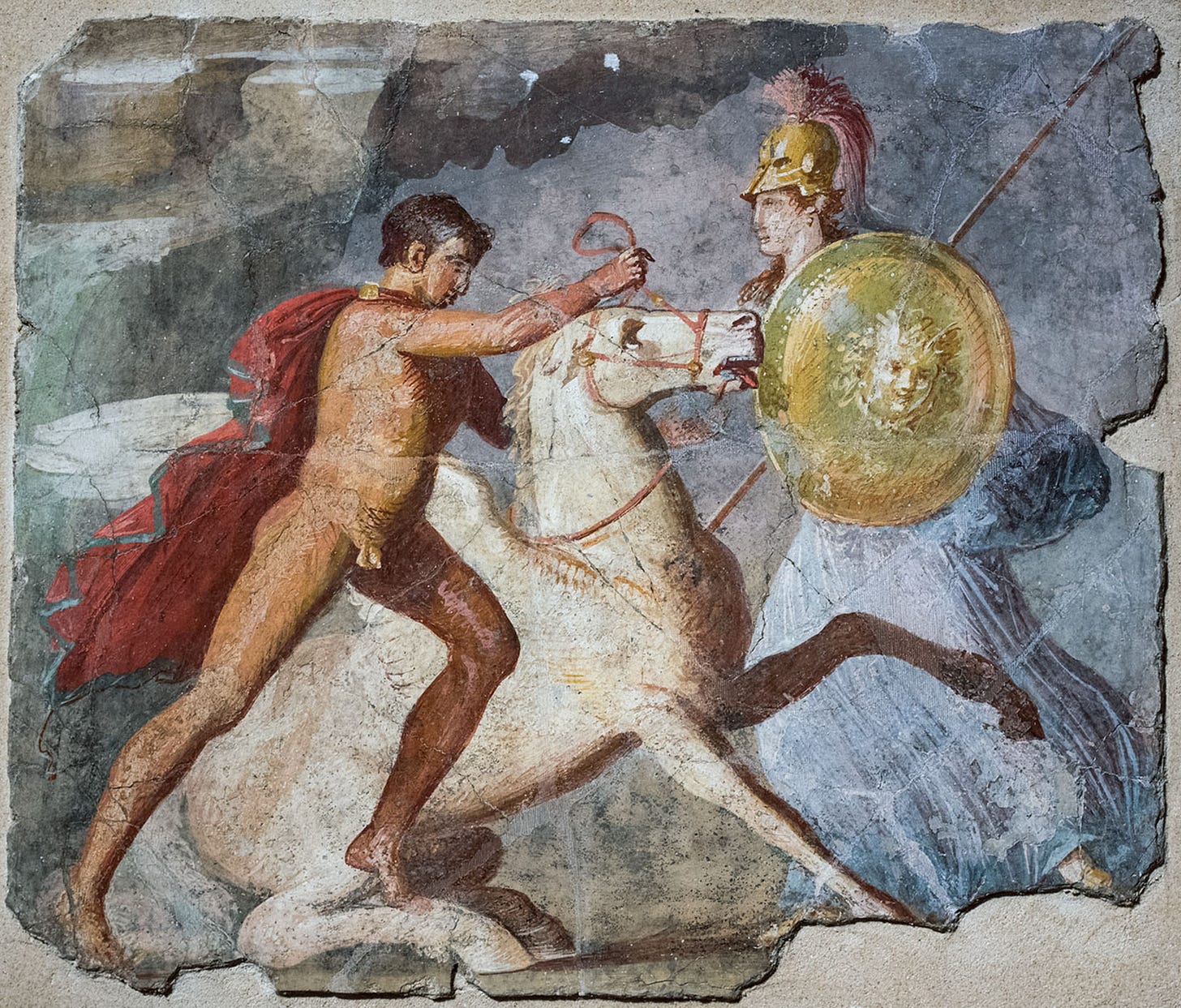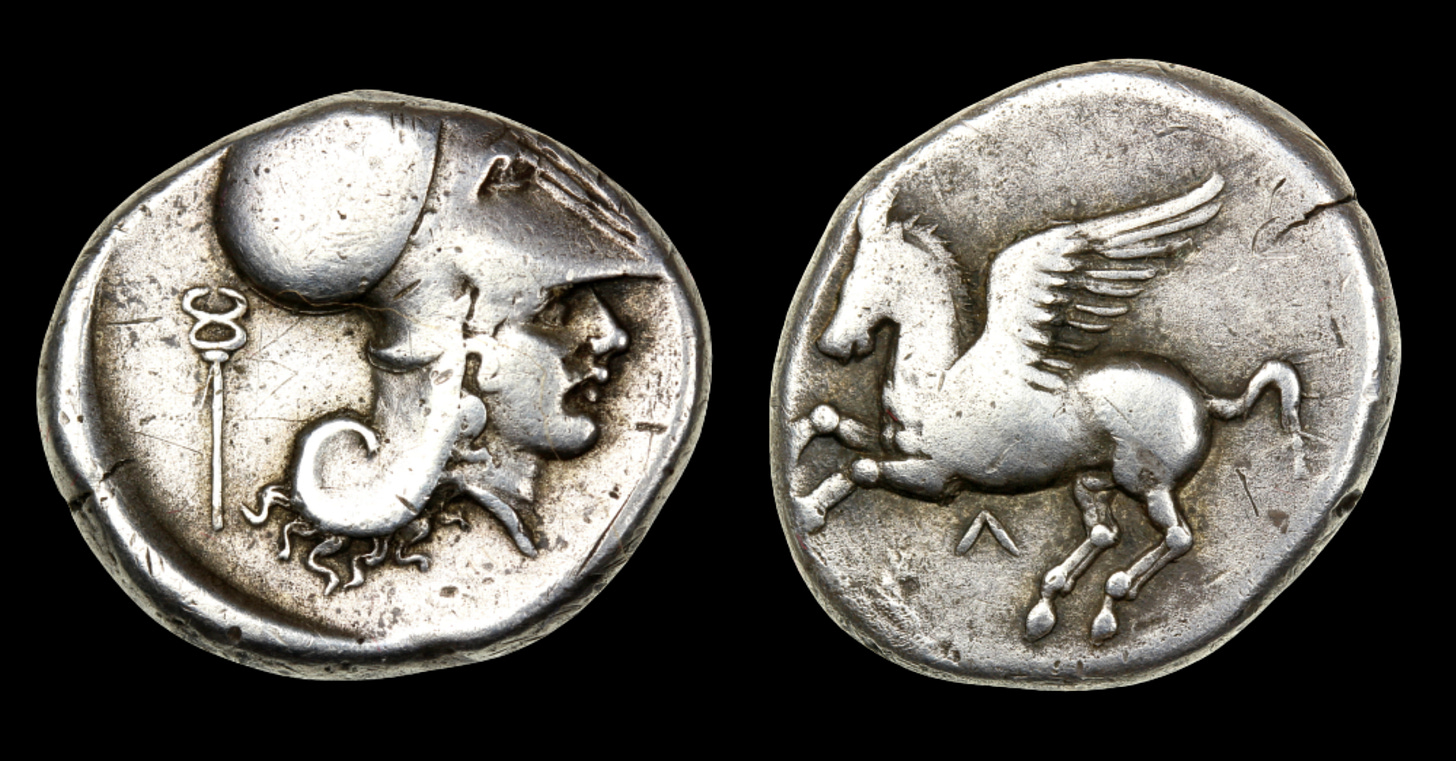By popular demand, this week’s issue will look at the Pegasos and its rider, Bellerophon!
Bellerophon
Bellerophon1, a son of Poseidon (god of the sea), murdered his brother.2 Local king Proetus of Tiryns (a city state in Argolis) kindly forgave Bellerophon, but the king’s wife soon fell in love with him. Bellerophon rejected her, and in anger she falsely accused him of seducing her. Proetus, furious, could not kill a guest, for that would be unholy and a violation of ξενία, the idea of hospitality. This was key for the Hellenes, an ethical responsibility just as important for Greeks today, millennia later. Still keen on revenge, he sent his guest to someone else in oder to relieve himself of the obligations associated with ξενία, and gave that man a message commanding his death.
But this other man only opened the letter after taking him in, so couldn’t murder Bellerophon, just like Proetus! Therefore, he ordered him to slay the Chimaera, which would definitely get him killed.
Pegasos
“When he [Perseus] saw Medousa, he beheaded her. As soon as her head was severed there leaped from her body the winged horse Pegasos and Khrysaor (Chrysaor), the father of Geryon. The father of these two was Poseidon.” - Pseudo-Apollodorus, Bibliotheca 2. 42
A Seer called Polyidus (literally “seeing many things” in Greek) gave Bellerophon the advice he seek the Pegasos to aid him on his mission. In order to do this, he was to sleep in Corinth’s temple of Athena. When he arose, Athena had already tamed the Pegasos for him3 and he was able to fly off, mounted on the winged horse, prepared for battle with the Chimaera.
Early 1st century fresco from Pompeii featuring Bellerophon, Athena and the Pegasos4
The Chimaera
The Chimaera was a fire-breathing beast part lion, goat and snake. Soon enough, Bellerophon realised that he was far too weak to slay such a monster, so he devised a cunning plan: Bellerophon found some lead and attached it to his spear, which he threw into the Chimaera’s mouth. As soon it breathed fire, the lead became molten and choked the beast.
This trihemidrachm depicts both Bellerophon on the Pegasos (obv.) and the Chimaera (rev.)5
Demise
Bellerophon returned to the king, who sent him on more impossible journeys, unwilling to believe he really had defeated the Chimaera. At last, when Bellerophon successfully overcame all these tasks, the king recognised his divine status and offered his daughter’s hand in marriage. But, alas, the myth doesn’t end here.
Bellerophon grew to be so arrogant that he desired more than the mortal world; he was owed a spot on Olympus, the home of the gods. Zeus grew very angry at his ascent; the perfect example of ὕβρις (too much pride) and sent a gadfly to prick the winged horse so that Bellerophon might fall down. The Pegasos was able to join Zeus forever, but Bellerophon, blinded from falling in a bush of thorns, lived in torment until his passing.
“Pegasos flying high in the air as swift in his course as the wandering wind, threw Bellerophontes.” - Nonnus, Dionysiaca 28. 167 ff
A Corinthian type stater depicting Athena, the bridler of horses, and the Pegasos6
Thanks so much for reading! If you liked this post, please consider telling your friends about Ancient Numismatics using the button below. Let’s give ancient history the attention it deserves!
It’s unclear who Bellerophon really killed. See https://en.wikipedia.org/wiki/Bellerophon
There are many variations on this: Bellerophon tamed the Pegasos while it drank, Poseidon gave Bellerophon the Pegasos, etc.
My coin, image credit to Silbury Coins







Thanks so much . I loved this post
Looking forward to the next one!